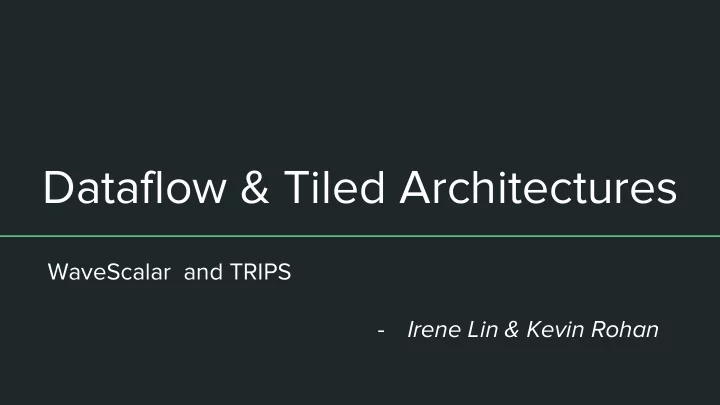

Dataflow & Tiled Architectures WaveScalar and TRIPS - Irene Lin & Kevin Rohan
WaveScalar ● Motivation ● Solution & Implementation ● Results ● Conclusion & Discussion
Motivation ● Scaling up superscalar is hard Circuit complexity, fast transistors, slow wires, communication ○ infrastructure ● Von Neumann means sequential ○ Sequential fetch (PC) and memory ● Untapped dataflow locality ○ predictability in the dynamic data dependencies
Solution & Implementation ● Chunk CFG into waves ● Every data value carries a tag, every wave has a wave number. ● Total ordering of memory operations From wave number and memory instruction sequence number ○ ● Increment wave number with WAVE-ADVANCE instruction ● Conditional split to steer data value to destination ○ Converting control dependencies into data dependencies
WaveCache Grid of processing elements for: ● control instruction placement ● input output queues ● communication logic ● functional unit Cluster of 4 PEs: ● L1 cache ● Store buffer **processor fetch is data-driven**
Results
Conclusion & Discussion ● “Scalable, low complexity, high performance” Is it actually scalable?? Compiler Scalability?? ○ ● Dataflow driven rather than von neumann style linearity Increase in parallelism ○ ● Binaries are bigger ○ Maybe not relevant in the present scenario ● Miss is a heavyweight event ● Compiler vs programmer responsibility Superscalar and WaveScalar both split up the program into blocks ○ Multi-core systems - programmer's responsibility ○
TRIPS ● Motivation ● Solution & Implementation ● Results ● Conclusion ● Discussion
Motivation ● Pretty much the same as before Scalability, reduce the circuit complexity etc. ○ Reduce burden on programmer ○ ● Does not replace Von Neumann architecture
Solution & Implementation EDGE ISA ● Block atomic execution ● Direct instruction communication within a block Micro Arch ● Operand Network (bypass reg file and memory) ● Tiles (global control, execution, register, data, instruction) Compiler ● Conventional optimizations ● Translate code to TRIPS intermediate language and make TRIPS blocks ● Translate blocks into assembly
“Need as many as 2– 4 times more instructions than the Alpha, due to aggressive predication.” Predication works by executing instructions from both paths of the branch and only permitting those instructions from the taken path to modify architectural state.
Memory Instruction ⇒ Register Instructions Register Instructions ⇒ Direct Communication
Microarchitecture Evaluation : ILP Evaluation
Microarchitecture Evaluation : v/s Commercial
Conclusion “the performance and potential energy efficiency of EDGE designs may be sufficiently large to justify adoption in mobile systems or data centers, where high performance at low power is essential.” Polymorphic processor - every task can run on every unit
Discussion WaveScalar vs TRIPS: ● Data-flow type of execution in both ● Inter-block communication: TRIPS - register file ○ WaveScalar - WaveCache ○ ● TRIPS is a Von Neumann architecture ● WaveScalar has 2.5 times more speedup as more parallelism
Recommend
More recommend